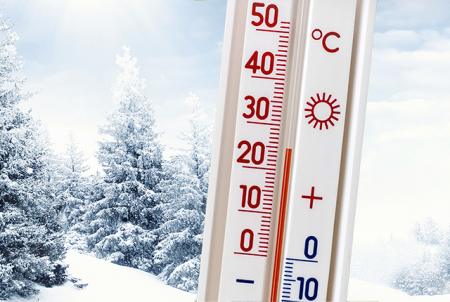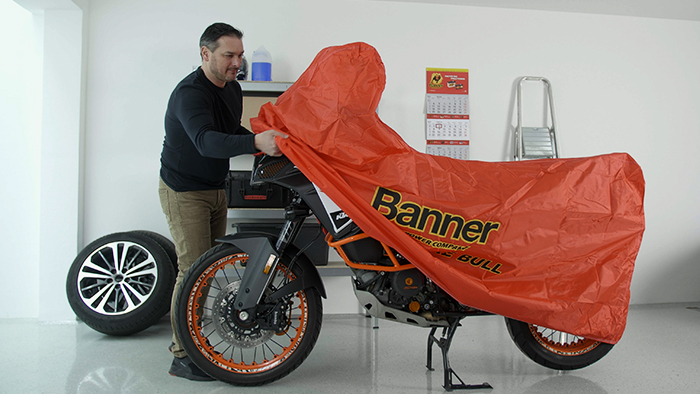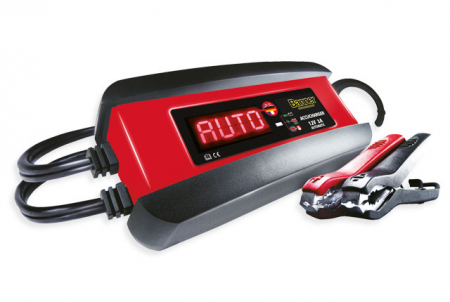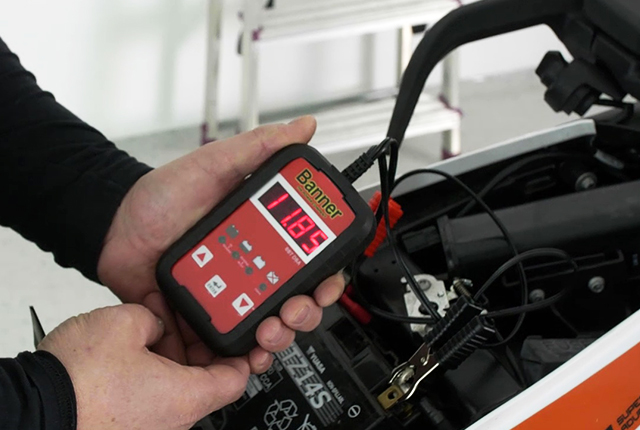HOW-TO: HIBERNATE A MOTORBIKE BATTERY
WITH CHARGE RETENTION
The motorbike season is over, so it's time to put the bike in the garage! If it’s foreseeable that the machine won’t be used for a while, it should also be properly stored. The Banner Battery experts have compiled some important tips here on the regular maintenance and optimal hibernation of motorbike batteries. All information here applies for the entire two-wheeled range, that is, motorbikes and the increasingly stronger market segments for mopeds and scooters.

Remove the battery or leave it in the motorbike?
That depends on the ambient temperature.
Temperatures between 0° C and +25°C
In a dry environment and at temperatures between 0° and +25°C, the battery can be left in the motorbike and connected to a Banner Accucharger with charge retention function. Please note: no cyclical permanent consumer, such as an alarm system or clock, may be connected. If permanent consumers cannot be switched off, at least unscrew the battery cables – always disconnect the negative terminal first.
Temperatures below 0°C
At temperatures below 0°C, our battery experts recommend removing the battery and storing it between 0° and +25°C in a garage or cellar and connecting it to a charger with a retention function – the Banner Accucharger is ideal for this. When removing the battery, first disconnect the negative cable and then the positive cable. After that, coat the poles with some Banner pole grease or pole protection spray. Warning: without a power supply, data in the on-board computer and radio …may be lost.
Please note: the ventilation tube must not be bent during storage (this does not apply to Bike Bull AGM, GEL and AGM PRO batteries).


Charging motorbike batteries –´how to do it properly
with the Banner Accucharger.
Ideally, you should use voltage-regulated chargers from the Banner Accucharger series. These devices take care of charging and charge retention fully automatically during storage periods and hibernation. Depending on the battery capacity, you can use the following chargers:
- Batteries <9 Ah - Banner Accucharger 6/12V 2A
- Batteries 9 - 20 Ah – Banner Accucharger 12V 3A
- Batteries > 20 Ah – Banner Accucharger 12V 6A Recovery
Recommendations for periodic battery checks
Banner battery Tester BBT DBA
We also recommend using the Banner Battery BBT DBA tester for periodic battery checks (voltage/cold start), especially if the charge retention is not maintained permanently!
Please make sure to recharge the battery as soon as an off-load voltage limit of approx. 12.5 V has been reached. To be able to measure the off-load voltage, you should wait approx. 5 hours after you have finished charging the battery (internally by alternator, externally by charger), or it has not been discharged for at least 1 hour.

Correct battery maintenance and storage
Maintenance: Carry out the maintenance and inspection tasks approx. every 3 months. Never leave the battery discharged. Keep the battery clean and dry, make sure the terminals are firmly seated and lubricate them.
Storage: When not in use and when stored for longer periods of time (non-use or winterisation period) at temperatures below 0°C, remove the battery and store it in a dry and cool (frost-free) place. The battery must be connected to a charge retention device (e.g. Banner Accucharger). In a dry environment and at temperatures between 0° and +25°C, the battery can be left in the motorcbike and connected to a Banner Accucharger with charge retention function.
Operating instructions Along with these tips, make sure to follow the operating instructions provided by the manufacturers of the vehicle and charger.
More articles on this topic






